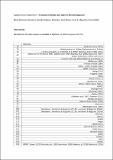Files in this item
A balance of winners and losers in the Anthropocene
Item metadata
| dc.contributor.author | Dornelas, Maria | |
| dc.contributor.author | Gotelli, Nicholas J. | |
| dc.contributor.author | Shimadzu, Hideyasu | |
| dc.contributor.author | Moyes, Faye | |
| dc.contributor.author | Magurran, Anne E. | |
| dc.contributor.author | McGill, Brian J. | |
| dc.date.accessioned | 2020-03-15T00:33:27Z | |
| dc.date.available | 2020-03-15T00:33:27Z | |
| dc.date.issued | 2019-04-08 | |
| dc.identifier | 258222889 | |
| dc.identifier | c3186dce-403f-49c8-b213-808ac9133f93 | |
| dc.identifier | 85062998610 | |
| dc.identifier | 000466402100009 | |
| dc.identifier.citation | Dornelas , M , Gotelli , N J , Shimadzu , H , Moyes , F , Magurran , A E & McGill , B J 2019 , ' A balance of winners and losers in the Anthropocene ' , Ecology Letters , vol. 22 , no. 5 , pp. 847-854 . https://doi.org/10.1111/ele.13242 | en |
| dc.identifier.issn | 1461-023X | |
| dc.identifier.other | RIS: urn:C50C1AA50E50FF632AE24D679D35414D | |
| dc.identifier.other | ORCID: /0000-0002-0036-2795/work/55643798 | |
| dc.identifier.other | ORCID: /0000-0001-9687-0593/work/55643816 | |
| dc.identifier.uri | https://hdl.handle.net/10023/19659 | |
| dc.description | The authors are grateful to the European Research Council (AdG BioTIME 250189 and PoC BioCHANGE 72744) for funding. MD is funded by a Leverhulme Fellowship from the Leverhulme Trust and by the John Templeton Foundation grant #60501 ‘Putting the Extended Evolutionary Synthesis to the Test’. BJM was funded by a USDA Hatch grant to MAFES #1011538 and NSF ABI grant #1660000. | en |
| dc.description.abstract | Scientists disagree about the nature of biodiversity change. While there is evidence for widespread declines from population surveys, assemblage surveys reveal a mix of declines and increases. These conflicting conclusions may be caused by the use of different metrics: assemblage metrics may average out drastic changes in individual populations. Alternatively, differences may arise from data sources: populations monitored individually, versus whole-assemblage monitoring. To test these hypotheses, we estimated population change metrics using assemblage data. For a set of 23 241 populations, 16 009 species, in 158 assemblages, we detected significantly accelerating extinction and colonisation rates, with both rates being approximately balanced. Most populations (85%) did not show significant trends in abundance, and those that did were balanced between winners (8%) and losers (7%). Thus, population metrics estimated with assemblage data are commensurate with assemblage metrics and reveal sustained and increasing species turnover. | |
| dc.format.extent | 8 | |
| dc.format.extent | 225141 | |
| dc.format.extent | 252297 | |
| dc.language.iso | eng | |
| dc.relation.ispartof | Ecology Letters | en |
| dc.subject | Anthropogenic | en |
| dc.subject | Biodiversity | en |
| dc.subject | Colonisation | en |
| dc.subject | Extinction | en |
| dc.subject | Population change | en |
| dc.subject | QH301 Biology | en |
| dc.subject | 3rd-DAS | en |
| dc.subject | BDC | en |
| dc.subject | R2C | en |
| dc.subject.lcc | QH301 | en |
| dc.title | A balance of winners and losers in the Anthropocene | en |
| dc.type | Journal article | en |
| dc.contributor.sponsor | European Research Council | en |
| dc.contributor.sponsor | European Research Council | en |
| dc.contributor.sponsor | John Templeton Foundation | en |
| dc.contributor.institution | University of St Andrews. School of Biology | en |
| dc.contributor.institution | University of St Andrews. Centre for Biological Diversity | en |
| dc.contributor.institution | University of St Andrews. Fish Behaviour and Biodiversity Research Group | en |
| dc.contributor.institution | University of St Andrews. Marine Alliance for Science & Technology Scotland | en |
| dc.contributor.institution | University of St Andrews. Scottish Oceans Institute | en |
| dc.contributor.institution | University of St Andrews. Institute of Behavioural and Neural Sciences | en |
| dc.contributor.institution | University of St Andrews. St Andrews Sustainability Institute | en |
| dc.contributor.institution | University of St Andrews. Centre for Research into Ecological & Environmental Modelling | en |
| dc.identifier.doi | 10.1111/ele.13242 | |
| dc.description.status | Peer reviewed | en |
| dc.date.embargoedUntil | 2020-03-15 | |
| dc.identifier.grantnumber | 250189 | en |
| dc.identifier.grantnumber | 727440 | en |
| dc.identifier.grantnumber | 60501 | en |
This item appears in the following Collection(s)
Items in the St Andrews Research Repository are protected by copyright, with all rights reserved, unless otherwise indicated.


